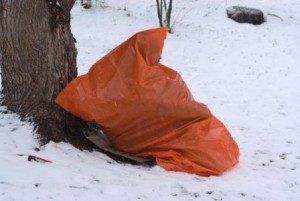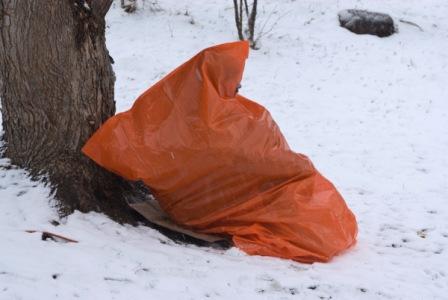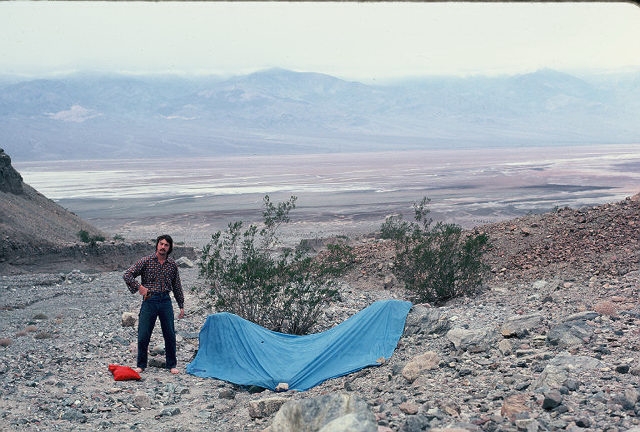Hypothermia directly causes death at least 1,500 times annually in the United States.
Here are some tips to help you avoid hypothermia, and some links for more specific information.
by Leon Pantenburg
Damn! It’s cold out here – my teeth are already chattering and I’m shivering like crazy! Then the dang wind has to come up. It’s getting colder. Funny how fast that happened. Maybe I should make a fire or something. Or not. Wasn’t going far, and didn’t want to carry that survival gear. I already quit shivering. It may not be that cold after all… In fact, I’m getting too warm… Guess I’ll take off some clothes…

Me as a hypothermia candidate, 1978, Unitas Mountains, Utah. It didn’t look like heavy rain and the car couldn’t be far…
The flannel shirt and cotton jeans are soaked from slipping off that log while crossing the creek. That down jacket is also soaked and worthless. But that’s not a big deal, really because I didn’t go that far from the trailhead…Good thing, because I’m kinda confused about directions…
The above scenario can easily happen. It has happened. Hypothermia, and possibly death, will follow shortly.
Hypothermia is defined as a core body temperature of less than 95 degrees Fahrenheit. (FYI normal body temperature is 98.6.) Hypothermia results from prolonged exposure to a cold environment, drugs, and/or underlying pathologic conditions. (National Library of Medicine) Hypothermia kills more people in the outdoors than just about anything. Annually in the United States approximately 1,300 people die of hypothermia, according to the Centers for Disease Control and Prevention.
Hypothermia can strike a stranded motorist in a stalled vehicle in a snow drift, an elderly person in a house with no heat or a boater in the Florida Keys who falls overboard.
Hypothermia isn’t just a danger in colder climates. In most cases, hypothermia occurs in temperatures between 30 and 50 degrees, but people can succumb at temperatures between 60 and 70 degrees. In Florida, for example, hypothermia most commonly occurs when boaters fall in the water during the winter. This can be a deadly situation if the boater isn’t wearing a life jacket because hypothermia can lose of consciousness and drowning.
Here are five tips to help prevent hypothermia.
Dress correctly: Your clothing is your first line of defense against hypothermia. If what you’re wearing has the right combination of fiber and design, the rest of these tips may be moot points.

Make a fire: Always have a lighter and some fire starter on your person. The ability to make a fire in a survival situation can save your life, to quote me, while the inability can cost it. Practice with your fire making tools and know how to find dry fire wood under extreme conditions.
One of the quickest and most efficient ways to raise that core temperature may be to make a warming fire, and the faster that can be done, the quicker a chilled person can get out of danger. Fire making is a critical skill and it is worthwhile to get good at it.

A 55-gallon trash bag can make a quick, effective emergency shelter. (Peter Kummerfeldt photo)
Take rain gear: Wet clothing cools your body much faster – up to 25 times faster if it’s cotton – than when it’s dry. Get good rain gear, and at the first sign of rain put it on. In the above photo, I was about 150 yards from the parking lot. The rain hit so hard and fast that I was drenched before I could think about taking my poncho off the pack.
Make a shelter: It is critical to get out of the wind and rain/sleet/hail/snow as quickly as possible. That means you need to be able to construct and get in your shelter as quickly as possible. I always carry a tarp, a space blanket (NOT a flimsy Mylar sheet) and a 55-gallon trash bag. With these materials, I can quickly make a shelter that protects me from most weather. Combined with the appropriate clothing, this setup will keep me alive overnight.
Leave a note: Nobody can find you if they don’t know where to look. Leave a note before going on any outing, no matter where. (Here is what to include in that note.) It is also a good idea to include a notebook and writing implement in your survival gear.
Preventing hypothermia is like preventing any other survival situation: Think ahead, plan your gear accordingly and take it with you, no matter how short of quick the trip might be.
Sources: “Hypothermia, Frostbite and Other Cold Injuries: Prevention, Survival, Rescue and Treatment” by Gordon G. Giesbrrecht, Ph.D. and James A. Wilkerson, M.D.



Leave a Reply